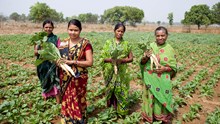
Phalsa, botanically known as Grewia asiatica and belonging to the Malvaceae family, has recently been recognized as a potential fruit crop for rainfed and low-fertility areas of India. The crop is known for its tolerance to hot and dry conditions with low water requirements, making it suitable for regions where traditional fruit crops fail. Phalsa is also valued for its rich antioxidant content, enhancing its domestic and international market value. As a promising crop for diversified agricultural practices, it offers farmers an opportunity to increase their income and has earned a place among such crops.
Cultivation Practice
Phalsa is remarkably easy to cultivate. It grows in various ranges of soils such as sandy fine sands to clay. pH between 6.0 and 8.5 suits the plant. Its hardiness in poor soil makes it suitable for rain-fed or marginal land. Subtropical regions with high temperatures at maturity support the fruit crop well. It loses its leaves when in a dormant phase during winter.
Farmers normally raise phalsa through seeds, which germinate within 15-20 days when soaked in water before planting. The ideal time for field planting is during the monsoon months, and seedlings at a spacing of 2.5 to 3 meters can accommodate as many as 1,500 plants per hectare. Proper pruning, done during December, encourages new growth and increases fruit yield and quality. Further, application of fertilizers like urea and farmyard manure after pruning significantly increases productivity.
Regional Adaptability
Phalsa can easily adapt to different regions in India. It may be grown in states like Jammu, Rajasthan, Gujarat, Madhya Pradesh, Uttar Pradesh, Bihar, Haryana, and Odisha since it grows well in both tropical and subtropical climates. It can be grown in places where other fruit crops might not survive due to its capacity to withstand high temperatures and flourish in low-fertility soils.
Its drought resilience makes it a dependable crop in areas with inadequate irrigation systems, giving farmers consistent revenue even during times of water constraint. Its small size also makes it possible to cultivate it as an intercrop in already-existing orchards, increasing agricultural output and land use efficiency.
Irrigation and Maintenance
Although phalsa can withstand drought, a little irrigation during the fruit development period boosts fruit output and quality. During the height of summer, irrigation at intervals of 15 to 20 days guarantees optimal development. Phalsa plants produce larger and more juicy fruits when micronutrients like ZnSO₄ and FeSO₄ are applied topically throughout the pre-bloom and berry-set phases. The crop is shielded against pests and diseases like Cercospora leaf spot by using good management techniques, such as setting up fruit fly traps and applying fungicides as needed.
Harvesting and Post-Harvest Management
When the fruit is set, after 60-65 days it is ready to get Harvested. The yields vary from 3 to 5 kilos per plant according to the soil and management practices. Harvesting fruits at the turning stage, storing them at moderate temperatures, and handling them carefully to avoid damage are all ways to increase their shelf life. Ripe fruits can be kept for up to seven days in cold storage at 5-7°C, but they only last a day at room temperature.
Health Benefits of Phalsa
In addition to being profitable, It is nutrient-dense and has many health advantages. Rich in antioxidants, the fruits support general health by reducing inflammation and oxidative stress. They are also a good source of dietary fiber, vitamins, and minerals. Phalsa has been used traditionally in medicine to treat skin conditions, digestive problems, and respiratory problems. Its juice is particularly well-liked for its capacity to boost immunity and provide cooling in the summer.
Economic Potential
Phalsa is a high-value crop for farmers, especially in rainfed and low-fertility regions. Its low water requirements and ability to grow as an intercrop make it a profitable option. Growing phalsa can generate a substantial income for farmers because the fruit's market value can be increased by selling it fresh or processing it into beverages that are ready to serve. It is a feasible crop for small-scale and marginal farmers due to the possibility of value addition through juicing and other processing methods, which adds another level of profitability. Fresh phalsa can be purchased for between Rs 200 and Rs 300 per kilogram, but processed goods like ready-to-serve drinks and essential oils can cost up to Rs 1,500 to Rs 2,000 per liter.
(price range can fluctuate according to region, season, and availability)
Farmers in rainfed areas and other subtropical locations have a great opportunity to cultivate phalsa. It is emerging as one of the promising crops for raising farmer incomes due to its high market value, health advantages, and capacity to adapt to low-fertility soils with little water requirements. With increased acceptance and knowledge, it might greatly improve farmers' livelihoods in challenging agroclimatic zones and help to agricultural diversification.
















